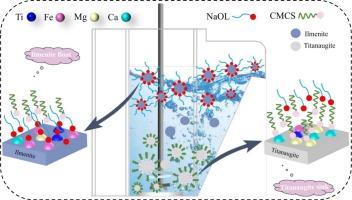Effects of high-efficiency depressant carboxymethyl chitosan on the flotation separation of fine-grained ilmenite and titanaugite: Experimental investigation and mechanism analysis
IF 6.9
2区 材料科学
Q2 CHEMISTRY, PHYSICAL
引用次数: 0
Abstract
This study employs carboxymethyl chitosan (CMCS) as a green depressant and systematically investigates its effect on the flotation separation of fine-grained ilmenite and titanaugite. Flotation tests demonstrated that in NaOL system, adding CMCS could achieve a concentrate with 33.09% TiO2 grade and 61.41% recovery, successfully realizing efficient separation of fine-grained ilmenite and titanaugite. Through Zeta potential measurements, FTIR spectroscopy, XPS analysis, ToF-SIMS, turbidity tests, and optical microscopy observations, combined with DFT calculations, the selective depression mechanism of CMCS was elucidated. The findings suggested that the –NH2 and –COO- groups in CMCS were adsorbed onto Ca and Mg sites on the titanaugite surface through hydrogen bonding and chemical adsorption, forming a stable hydrophilic layer, while selectively inducing the flocculation of fine-particle titanaugite. In contrast, CMCS exhibited weaker interaction with ilmenite, allowing ilmenite to be effectively collected by NaOL. DFT calculations further confirmed that the N and O atoms in CMCS’s dual functional groups (–NH2 and –COO-) formed chemical bonds with Ca and Mg atoms on the titanaugite surface through electron transfer and orbital hybridization, significantly enhancing the stability of binding. Therefore, CMCS demonstrated remarkable depression performance in the flotation separation of fine-grained ilmenite and titanaugite through selective chemisorption and bridging flocculation.

高效抑制剂羧甲基壳聚糖对细粒钛铁矿和钛辉矿浮选分离的影响:实验研究及机理分析
以羧甲基壳聚糖(CMCS)为绿色抑制剂,系统研究了其对细粒钛铁矿和钛辉矿浮选分离的影响。浮选试验表明,在NaOL体系中添加CMCS可获得TiO2品位为33.09%、回收率为61.41%的精矿,成功实现了细粒钛铁矿和钛辉矿的高效分离。通过Zeta电位测量、FTIR光谱、XPS分析、ToF-SIMS、浊度测试和光学显微镜观察,结合DFT计算,阐明了CMCS的选择性抑制机制。研究结果表明,CMCS中的- nh2和- coo -基团通过氢键和化学吸附作用吸附在钛辉石表面的Ca和Mg位点上,形成稳定的亲水层,同时选择性地诱导细颗粒钛辉石絮凝。相比之下,CMCS与钛铁矿的相互作用较弱,这使得NaOL能够有效地收集钛铁矿。DFT计算进一步证实了CMCS的双官能团(- nh2和- coo -)中的N和O原子通过电子转移和轨道杂化与钛辉石表面的Ca和Mg原子形成化学键,显著增强了结合的稳定性。因此,CMCS通过选择性化学吸附和桥接絮凝对细粒钛铁矿和钛辉矿的浮选分离表现出显著的抑制作用。
本文章由计算机程序翻译,如有差异,请以英文原文为准。
求助全文
约1分钟内获得全文
求助全文
来源期刊

Applied Surface Science
工程技术-材料科学:膜
CiteScore
12.50
自引率
7.50%
发文量
3393
审稿时长
67 days
期刊介绍:
Applied Surface Science covers topics contributing to a better understanding of surfaces, interfaces, nanostructures and their applications. The journal is concerned with scientific research on the atomic and molecular level of material properties determined with specific surface analytical techniques and/or computational methods, as well as the processing of such structures.
 求助内容:
求助内容: 应助结果提醒方式:
应助结果提醒方式:


